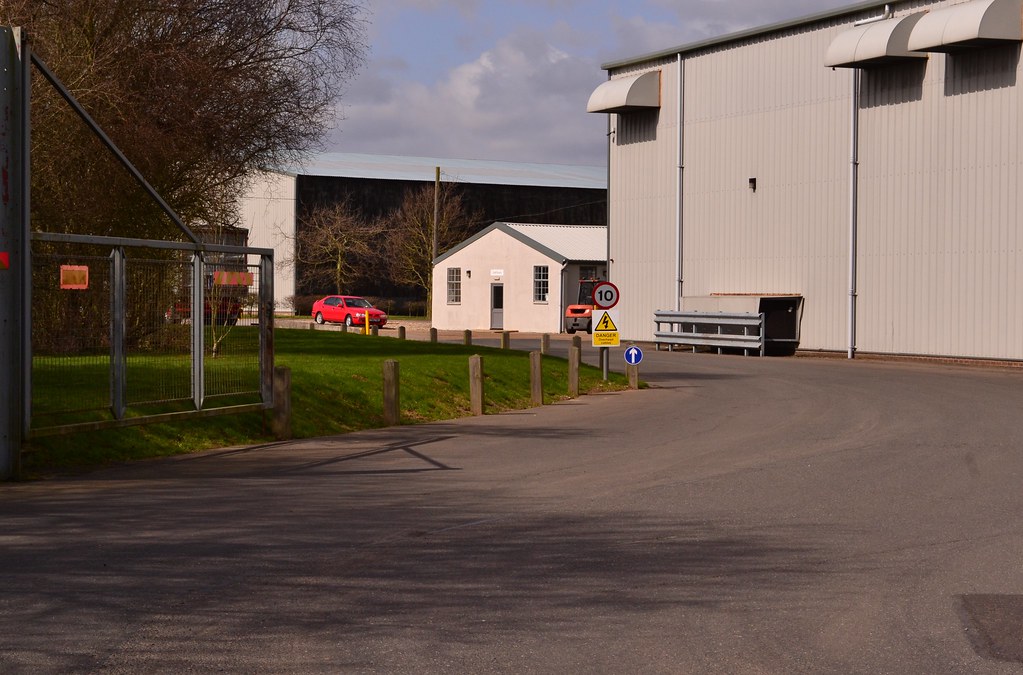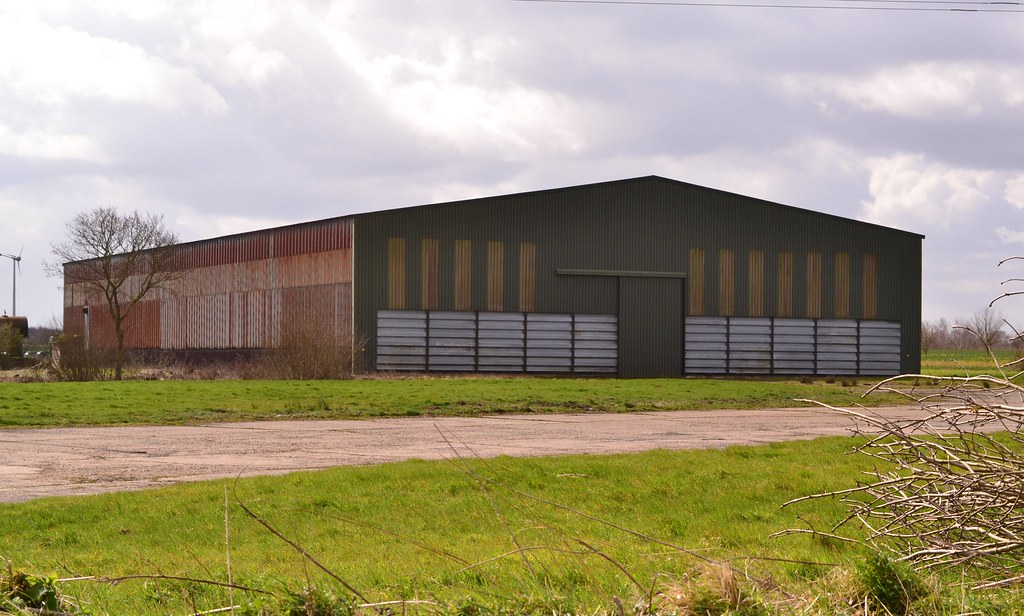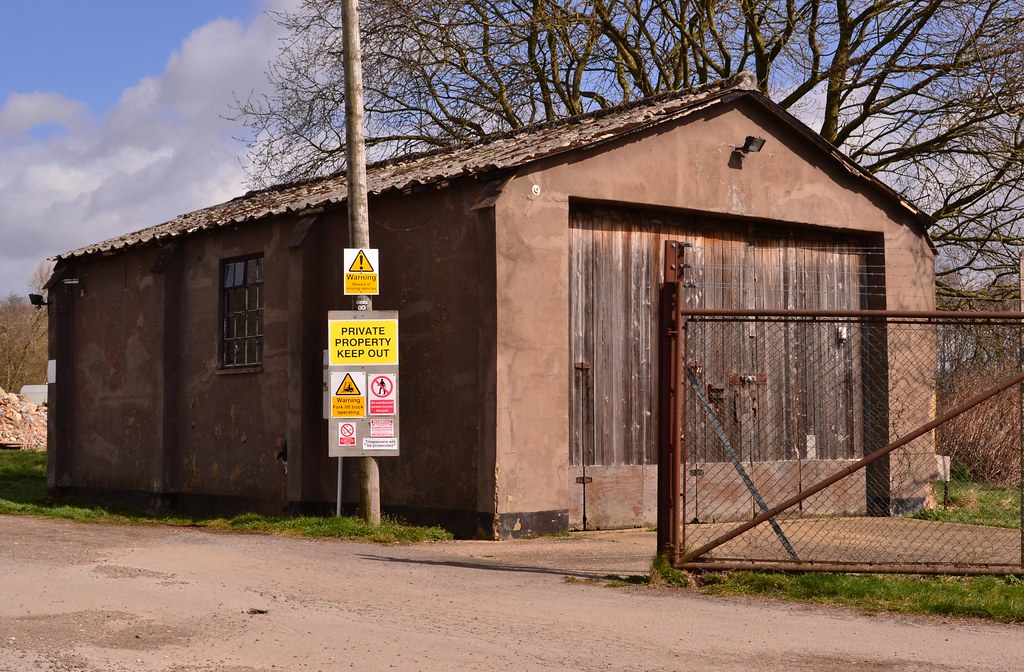The first airfield in this Trail reveals some excellent examples of wartime architecture. A short life, but an important one, it saw a wide range of aircraft undertaking some ground breaking activities.
We visit RAF Foulsham.
RAF Foulsham

Halifax B Mark III, MZ817 ‘DT-O’, of No. 192 Squadron RAF after crash-landing while taking off from Foulsham, on a radar surveillance sortie. 9th December 1944*1
Foulsham, like many of its counterparts in this region played a major part in the electronic war, monitoring and jamming radar transmissions for larger formations of bombers. Despite this important and ground breaking role, Foulsham had only a short operational existence.
Built in the latter parts of 1941, Foulsham had three runways, 37 dispersals and 9 hangars. It was initially opened with light bombers of 2 Group Bomber Command. These were primarily Mitchell IIs of 98, 180 and 320 Squadrons; 320 being formed entirely of Dutch personnel. A detachment of Glider storage and maintenance personnel from 12 GMS were also at Foulsham between April 1943 and March 1944 preparing and maintaining Horsa Gliders for the forthcoming Normandy invasion. In this same year, on September 1st, 3 Group Bomber Command took over responsibility of Foulsham and the much heavier Lancasters of 1678 HCU (Heavy Conversion Unit) and 514 Squadron arrived for operational duties over Europe. One month later, the American 375th Servicing Squadron (SS) arrived and began modifying de Havilland’s ‘Wooden Wonder’ the Mosquito, for photographic reconnaissance duties, a role the Mosquito excelled at.
Once more, Foulsham changed hands and it became part of the now familiar 100 Group, who were dominating this area of the country. 192 Squadron arrived with a variety of aircraft, the HP Halifax, Mosquito, Anson and Wellington for electronic warfare operations. Other squadrons soon joined them, and Foulsham became a large operational base shrouded in secrecy. Between 1943 and post conflict in 1946, more Wellingtons, Mosquitos, P38 ‘Lightnings’, Stirlings and Halifax IIIs arrived all becoming common place in the skies over Foulsham as they gathered information, trialed radio and electronic jamming operations and evaluated new methods of electronic warfare.
Foulsham was further graced in 1944 with the installation of FIDO, the fog clearing system, a method designed to burn away sufficient amounts of fog to enable a safe landing in difficult conditions; not always successfully. However, despite all this, Foulsham’s operational life was soon to be cut short and in June 1946 it was closed to flying duties, whereupon it became the final resting ground for a large number of Mosquitoes prior to scrapping. Foulsham remained ‘in-service’ until 1955 with the US Army, and then in the hands of the MOD until deemed surplus to requirements, it was finally sold off in the 1980s and its doors closed for the last and final time.
Many of Foulsham’s buildings have surprisingly withstood the test of time. Whilst the runways have all but gone, now farm tracks and tree lines, some of the buildings do still remain and even from the roadside, you can see what must have been a remarkable place during its short, but hectic life. The road passes along the eastern side of the airfield, here, you can still see a number of the original T2 hangars, 3 in total, now utilised by a local potato business. (‘Addison Farm’ as it is aptly named, is in recognition of Air Vice Marshall Edward Barker Addison, the only person to Command 100 Group*2 during the war). Whilst two of these hangars have been re-clad, the third is still in its original metal. Hidden amongst these structures, are some of the original technical buildings, again some refurbished some original. The mass concrete bases signify the manoeuvring areas linking this area to the main section of the airfield to the west.
At this point, there was until recently, gates separating the dispersal area to the east (now farm dwellings) to the hangar area on your left. During the War, this road was surprisingly open to the public and aircraft would be manoeuvred across the road, traffic being halted by an RAF Policeman.
Further to the north, beyond this area passing an air raid shelter, is the original entrance and further technical area.
A pill-box, marks where the main entrance was. Turn left here and follow the road west. To your right you pass the original Fire Tender shed, a B1 hangar and other minor buildings in varying states of disrepair. To your left, a further T2, partially refurbished partially original. Further along, the road crosses the original N/S runway, full width remnants to the right and a tree-lined track to the left mark clearly where the enormous concrete structure was laid. The road ahead, is the where the 08/26 runway ran as it disappears over the brow of the hill. The road then turns away north leaving the runway and airfield behind you.
As with all airfields, the accommodation blocks and bomb stores were scattered well away from the main airfield. With some searching, evidence of these may be found amongst the hedges and trees, public roads utilising the concrete sections of RAF road laid down originally.
Whilst the main layout of Foulsham is difficult to see from the road, the last remaining buildings have fared quite well and remain some of the better examples of original wartime architecture. There is a distinct ‘feel’ to the site that transforms you back in time to the days when heavy bombers and lighter twin-engined aircraft would rumble along its runways. Recent and ongoing development work by the farmer seems to be sympathetic and ‘in tune’ with the site, many buildings being reclaimed from nature and now ‘on show’ to the passing public. Whilst all are on private land, they are easily seen and it seems that there may be a winning formula here that other land owners could quite easily follow and preserve what is left of our disappearing heritage.
The wartime memories project, has a section focusing on RAF Foulsham and people trying to trace crew members who served there. It is worth a look through perhaps you may know someone from there.
In the nearby village of Foulsham, beneath the village sign, stands a memorial to the crews and personnel of RAF Foulsham.
From Foulsham, we head north-west, to a little airfield with the quaint name ‘Little Snoring’.
*1 photo from Royal Air Force Bomber Command, 1942-1945.© IWM (HU 60601)





A fascinating website – thank you. I am researching the stories of men of the City of London Police during World War II. One of them, Pilot Officer Henry Carley, flew from Foulsham. I have written about him here: http://www.ploddinthesquaremile.co.uk/pc-103e-carley-pilot-officer-royal-air-force/
LikeLiked by 1 person
Hi Rebecca, thank you for the comment and the link. I shall take a proper look on my return from my current holiday. Good luck with your research.
LikeLike
Hi there,
I just wanted to say that I really appreciated your page as I’m currently retracing my grandfathers steps in Foulsham as a pilot in then war (I have added another comment to a chain of replies below).
Cheers Rohan
LikeLiked by 1 person
Hi Rohan
Thank you for your kind comments and for the additional note you added. I’m glad you enjoyed the post and hope that you are able to find all the things you are looking for. By writing about these places I hope that the memories of those who served from them are kept alive and that their family members, like yourself, can see what it was like for themselves. It was a truly remarkable time in history and one that, I feel, ahold never be forgotten. Good luck on your trip, if you have any personal stories or photographs from your grandfather and wish to share them, please feel free to let me know and I’ll add them on the site. I wish you well and thanks again for reading.
LikeLike
Another really interesting account. You need to think of investing in a helicopter so that you could photograph from above all the features which are nowadays overgrown or ploughed through. Well, it was just an idea!
LikeLiked by 1 person
That’s brilliant. Maybe one day when I’m rich and famous I’ll do that…if only! Thanks as always
LikeLike
Hi there,
I love your ‘visit’ to Foulsham and wonder if any readers might be interested in knowing what it was like during wartime, actually being at Foulsham as an airman? I have a collection of booklets each focusing in words and pictures on airfields which came under RAF 100 Group, including RAF Foulsham and RAF Little Snoring,. It remains my passion to preserve their history and the stories of people who served there. As a founding member, Secretary of RAF 100 Group Association, and in touch with veterans around the world, every wartime experience shared with me is so precious. I create a quarterly magazine, bringing their stories out of the shadows, but now have two books coming out this year which are crammed with their history and writings. Anyone interested just needs to make contact with me. Our Association has 200 members worldwide, very much kindred spirits, retain that connection forged in wartime.
Thanks for your writings here. Anything we can do to bring these very special ‘gems’ of history out of the shadows and into the light has my blessing!
Best wishes,
Janine
LikeLiked by 1 person
Hi Janine, thanks for the comment. Your work sounds really
Interesting and full of passion, I too believe the memories of those who served and the places they served at should be kept alive – hence the blog. I am certain some of the readers would like to know more or even read some of your books / magazines. Is there a web address we can use? Please feel free to add it here, I can promote it for you or at least pass it on to my readers. I for one would like to know more of these fabulous places.
Kindest regards and thanks for visiting.
Andy.
LikeLike
Hello Andy,
Thanks for your response. I wasn’t sure if I was being cheeky or not! And yes, it remains my passion that all airfields in Norfolk, together with those who flew from them, be remembered, their history preserved. I’m down there at a Reunion I arrange for RAF 100 Group Association to which they come from across the world. It remains in their hearts also, their wartime home. I’ve known and worked alongside them now for over twenty years, and even now, stories are shared by those who never spoke about it before. New truths … and yet under RAF 100 Group at least there remain so many secrets which can never be told.
I was inspired by my mother’s story of her wartime fiance Vic Vinnell of 192 Squadron at Foulsham, who, together with Canadian pilot Jack Fisher never returned from a secret op on 26/27 Nov 1944. It is in their memory, and all who flew under this secret Group, that I continue to write with a passion.
The Group’s website is – http://www.raf100groupassociation.org.uk. My website and a link to contact me direct is http://www.JanineHarrington.blogspot.com.
Thanks again for your contact,
Janine
LikeLiked by 1 person
My pleasure Janine, it’s always good to find others who have similar passions. Thanks for the links, I’ll take a look and add them to the page over the next few days or so, there is always so much that could be covered in these posts it’s hard sometimes to know what to add and what not to. I’m sure my readers will be very interested in the work you do and want to take a look. Thanks again and it’s great to have crossed paths. 🙂 Andy
LikeLike
Hi Janine,
I would be very interested in reading your books. I’m currently visiting Foulsham and where my grandfather Geoffery Max Langworthy (Boong as his crew called him) piloted the Halifax bomber during the war. He returned to Australia following the war and my English grandmother who he met during the war later came over to join him.
About 4 years ago he and my father came and visited Foulsham as well the reconstructed Halifax bomber in the South Yorkshire air museum (my next stop). I understand that when he was here last he by chance met a local historian who was writing about the airforce history in the area. Are you familiar with this?
Anyhow I look forward to discussing more but I’m off to discover the local hall where he organised a birthday party for his mate during the war (someone borrowed his plane that night and got shot down), the pub where they drank and the airfield that they taxied the massive planes around.
I am very proud of what he and so many brave young men did during the war. I can’t even imagine how terrifying it must have been.
LikeLiked by 1 person
You might like to order from Amazon my book ‘RAF 100 Group – Kindred Spirits’ which brings together the voices of veterans who served at each of the airfields in Norfolk under this very secret Group, including RAF Foulsham, of which No. 192 was the lead Squadron, going out in all weathers, working directly with Blechley Park, and whose work remains shrouded in layers of secrecy to this day under a 100 Year Rule. A copy of this book has gone to the Queen, as well as Prime Minister at their request. I do however, have a few copies left of a ‘Collectable’ edition of this book, including original veteran signatures. For one of these you would need to contact me direct:
raf100groupassociation@gmail.com
I am author of 24 published books, but now focus on bringing RAF 100 Group and their remarkable work as well as the lives of those who served out of the shadows and into the light. Otherwise, they remain very much our ‘forgotten heroes’.
Janine
LikeLiked by 1 person
Well written as always my friend. Not enough is known about the electronic war. I may have to remedy that with DotR
LikeLiked by 1 person
Thanks Tony. I was a little unhappy with this one, it felt rushed but lots of interesting goings on and a fabulous place to visit. It really does have some terrific History to it. This whole trail and area in general, is filled with history that I knew little or nothing about until now. It’s been an interesting one and still a few more to go. The electronic warfare produced some rather interesting aircraft variations and would benefit from further writing.
LikeLiked by 1 person
For electronic warfare in the European Theater of Operations, Alfred Price’s Instruments of Darkness is a good start.
LikeLiked by 1 person
Another good one to look out for. Thanks as always.
LikeLike
It is a good starting point if you want to explore the topic.
LikeLiked by 1 person
Thank you for the suggestion.
LikeLike
I know…
LikeLiked by 2 people
Reblogged this on RAF 23 Squadron and commented:
We are getting nearer and nearer…
LikeLiked by 1 person
Thanks for the reblog Pierre. Next stop is for you!
LikeLike
Thanks for the reblog Pierre. The next one is for you!
LikeLike
I have been waiting a long long time for your visit to Little Snoring…
LikeLiked by 1 person
Thanks Pierre. It’s next!
LikeLiked by 1 person